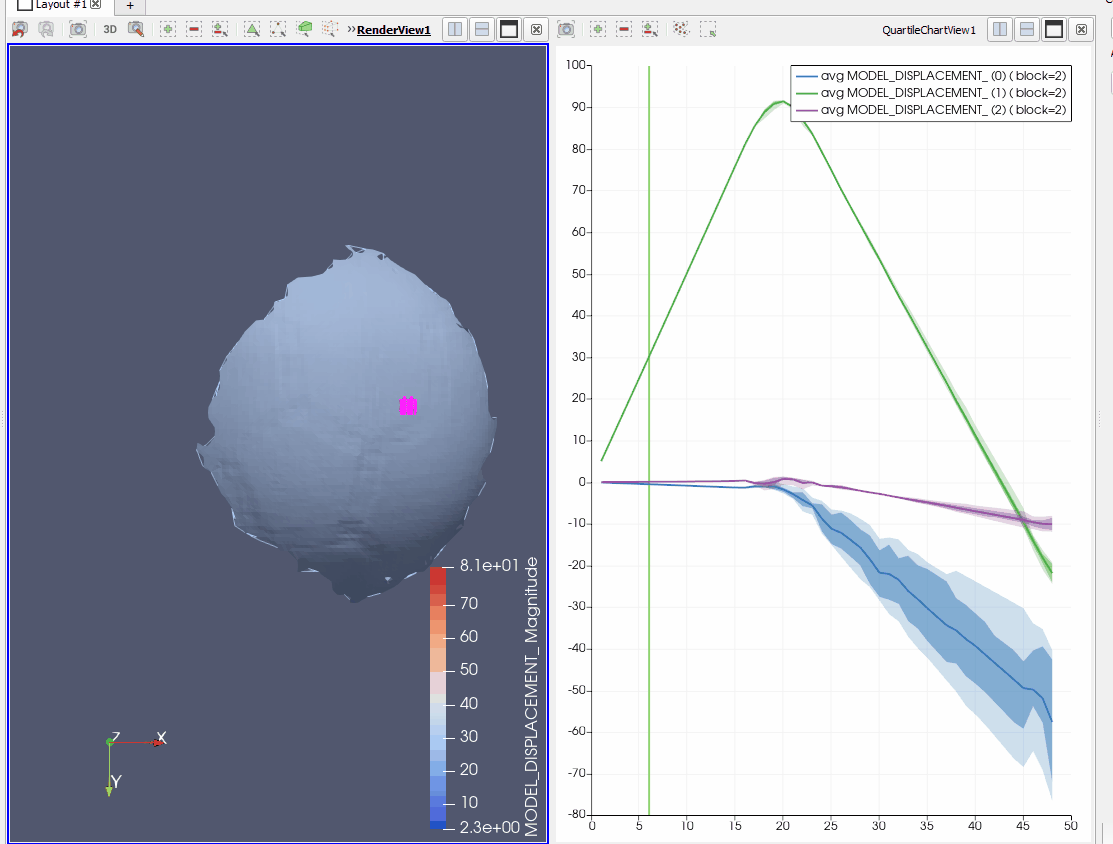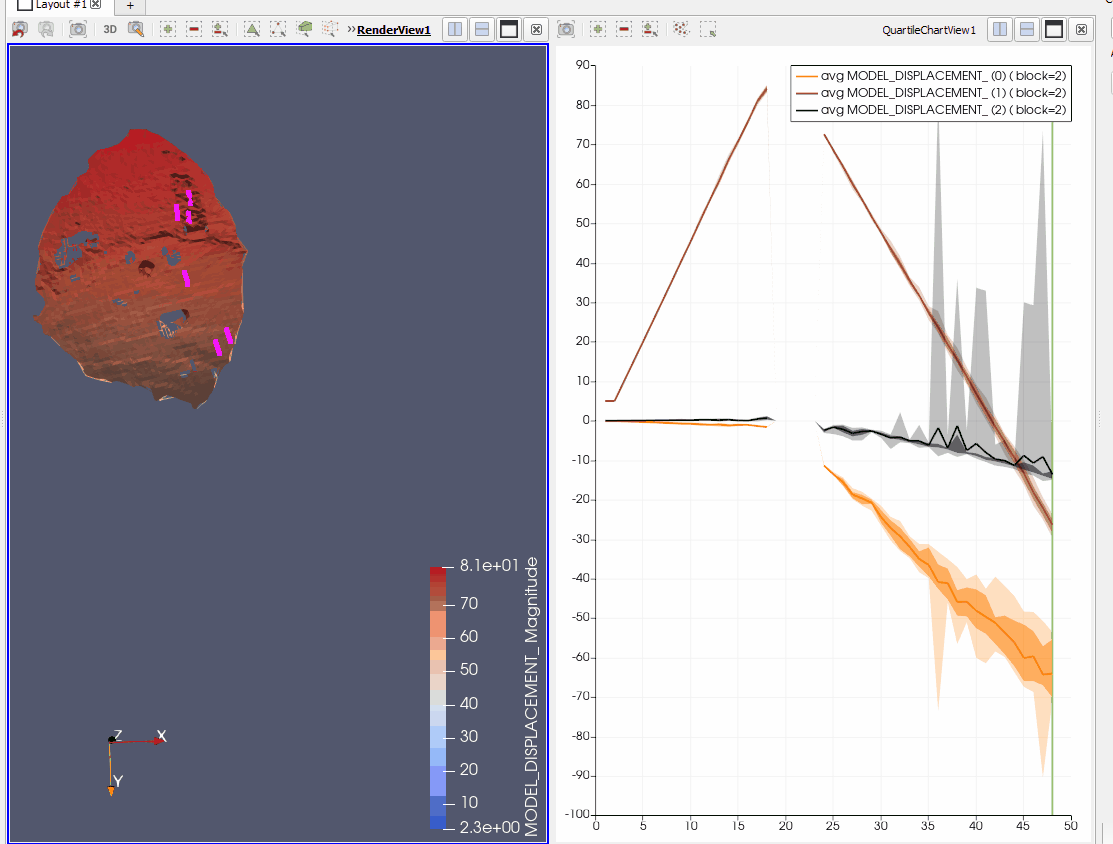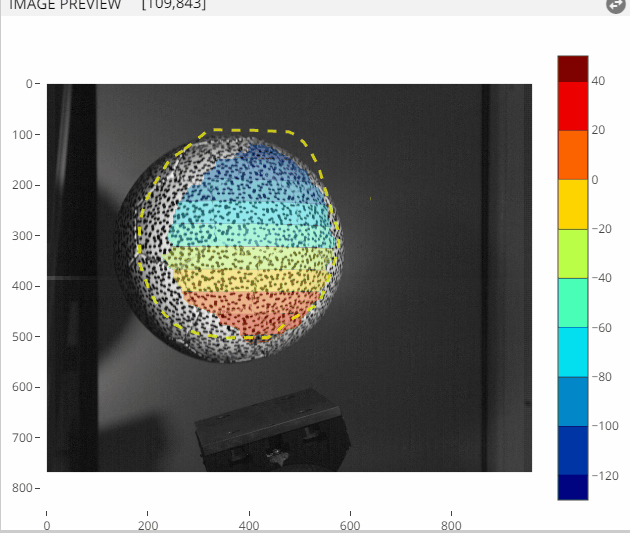dice
 dice copied to clipboard
dice copied to clipboard
incremental vs initial reference
Hi Dr Turner,
We are doing stereo-DIC on football impact and trying to compare the results obtained from the ‘initial reference’ and the ones from ‘incremental correlation’. The results from ‘initial reference’ appear very good; see the first figure. The ones from ‘incremental correlation’ are shown in the second figure. The time history of displacements at several selected points is also plotted in the figures. The incremental y-displacements superimposed on the left images are shown in the third figure.
A few observations from the ‘incremental’ results may not be intuitive:
- The valid region (mesh) ‘collapses’ into a much smaller region during the impact. See the 2nd and 3rd figures. However, the mesh gradually re-expands to its original size after the impact. This is not observed in the results when only the first image is used as the reference.
- The displacements at the selected points are missing in the time history plot during the ‘impact event.’ Not sure why it can be picked up again after the impact.
- The variations of displacement between the selected points appear significant after the impact. They are also greater than the results from ‘initial reference’.
- When I run the ‘incremental correlation’ only on the left images for a 2D DIC, the program terminates with a ‘fail’ popup dialogue box. It stopped at the instant around two/three frames before the ‘impact’. However, no error message can be found in the console. Not sure why the stere-DIC can get around these few frames during the impact event, but the 2D correlation is stuck here. By the way, there is no problem with a 2D run when the initial reference is applied.
- The selected point re-distributed to everywhere after the impact, perhaps this is an issue in ParaView.
Is it possible to share your view on these observations, please? The only different parameter between the two sets of results is ticking the ‘use incremental’ option in the GUI.
Thank you in advance. Wei
 Fig 1. stereo-DIC of ball impact test - initial image is used as reference'
Fig 1. stereo-DIC of ball impact test - initial image is used as reference'
 Fig 2. stereo-DIC of ball impact test - incremental correlation is used.
Fig 2. stereo-DIC of ball impact test - incremental correlation is used.
 Fig 3. stereo-DIC results from incremental correlation that superimposed on the left images
Fig 3. stereo-DIC results from incremental correlation that superimposed on the left images
The images are attached here as well - converted from bmp to jpg due to the file size limitation here. angledrop.zip
Let me take a look and see what's going on. Which version of DICe did you use for the results above?
Let me take a look and see what's going on. Which version of DICe did you use for the results above?
tried on both V3.B5 and V3.B6. Same results.
Unfortunately, with the images being converted to jpg I can't use the same calibration file you included in your dataset above. Would you be willing to re-upload the images and only include the first ten or so from each camera so you don't have to compress the originals?
I split all BMP images into four zip files. Two for the left and two for the right. Perhaps it would be better to have the whole image sequence, particularly for the 'incremental case'. Many thanks.
left_1stHalf.zip left_2ndHalf.zip right_1stHalf.zip right_2ndHalf.zip
I was able to run this problem with and without the incremental formulation and the results are very similar. I don't get the region of interest shrinking for the incremental formulation like you show above. There must be a difference in the parameters we are using. Can you upload your input.xml and params.xml files so I can compare the differences between yours and mine?
Thanks for the swift reply. Both the XML files are here: input_n_Param.zip I am thinking the shape functions...
A couple things to keep in mind:
- The incremental formulation has higher errors than when using the same reference image for each frame. This is due to the well-known fact that errors accumulate for the incremental formulation. We don't typically recommend using the incremental formulation unless there is too much deformation going on to use the usual DIC formulation. In your case it seems like the incremental formulation might not be necessary.
- Your subset size (25) is a bit small for your speckle pattern. I would use something closer to 3 times the speckle size in pixels, which would be roughly 31-36.
- For this set of images, the incremental formulation is having a hard time with the initialization step. This is why the subsets along the outer periphery are failing. The initial guess for these subsets is not close enough to converge.
Given the information above, you have a few options. I don't think there is anything wrong with the incremental formulation, it just doesn't seem needed for this problem. If you really want to use the incremental formulation you would probably need to use a different initialization option like USE_FIELD_VALUES, but for this initializer to work, you would need to increase the frame rate so the distance traveled by the ball between frames was smaller (which kind of defeats the purpose of using an incremental formulation). The feature matching initializer may be failing because there is a lot of rotation on the features that you are trying to track. There are other initializer options, but you would have to run DICe from the command line and update the params.xml file manually with the option you choose.
Hope that helps.
Thank you for the suggestions. I tried different initialization options including, 'field values', 'image registration' and 'neighbour values'. but it seems that all subsets return -1 for the GAMMA values. The only initialization option that would return 'valid' subset results is the 'feature matching'. Also, I tried to increase the subset size to 31-36 as suggested. Similar results were observed, i.e. the region of interest collapses during the impact, with the 'feature matching' initialization option, and there was no valid result returned with other initialisation options. Not sure what I did differently. would you mind sharing your input files that work well for the incremental correlation, please? Many thanks.
We may need to increase the impact speed in future tests. The impact deformation could be large. That's why we would like to try the 'incremental correlation' option. Just wondering if it is possible, in the command line mode, to define reference images in a hybrid way. e.g. define every 10th image as the reference as its following 9 images. Thanks a lot.
I still think you are better off increasing the frame rate for the images rather than switching to an incremental formulation. If you do want to do something custom with the updating the reference image every ten frames you could easily do that from the command line with a new input file (which defines the reference image) every ten frames. In this case you wouldn't even activate the use_incremental_formulation flag since you are updating the reference image manually. This would probably also avoid the issues you ran into above using the incremental formulation. Let me know what happens. I'm interested to hear how it turns out.